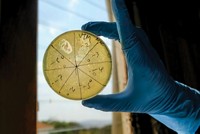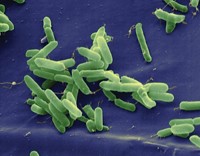Advertisement
Grab your lab coat. Let's get started
Welcome!
Welcome!
Create an account below to get 6 C&EN articles per month, receive newsletters and more - all free.
It seems this is your first time logging in online. Please enter the following information to continue.
As an ACS member you automatically get access to this site. All we need is few more details to create your reading experience.
Not you? Sign in with a different account.
Not you? Sign in with a different account.
ERROR 1
ERROR 1
ERROR 2
ERROR 2
ERROR 2
ERROR 2
ERROR 2
Password and Confirm password must match.
If you have an ACS member number, please enter it here so we can link this account to your membership. (optional)
ERROR 2
ACS values your privacy. By submitting your information, you are gaining access to C&EN and subscribing to our weekly newsletter. We use the information you provide to make your reading experience better, and we will never sell your data to third party members.
Business
Giving Bacteria A Virus
Start-ups look to bacteriophages for both diagnostics and human disease
by Marc S. Reisch
December 8, 2014
| A version of this story appeared in
Volume 92, Issue 49

The company Tim Lu and Michael Koeris started in 2009 began as a project to clear chronic bacterial infections in patients with catheters. They hit upon using a predatory bacteriophage, a type of virus that penetrates and destroys host bacteria, as an alternative to traditional antibiotic therapies.
Therapeutics didn’t pan out. Instead, today their firm, Sample6, offers a bacteriophage-based diagnostic that detects Listeria contamination in food after about six hours. Sample6 claims that the test’s accuracy and speed improve on existing immunoassays, cultures, or polymerase-chain-reaction-based tests for the bacteria, allowing food-processing facilities to act quickly to keep contaminated food off store shelves.
The journey Boston-based Sample6 took from therapeutic agents to diagnostics reveals both the pitfalls and potential of bacteriophages. It is a journey that other start-ups, such San Francisco-based EpiBiome and France-based Pherecydes Pharma, are navigating now in human and animal health.
Sample6’s test works by dosing a food sample with a specially engineered bacteriophage that only targets Listeria. Instead of multiplying inside and immediately killing the Listeria host, the engineered phage infects the cell and shuttles in the genetic instructions to make it produce an easily detected light-emitting protein.
“We’re turning the bacteria into little fireflies so they light up on their own,” says Lu, now an associate professor in the department of biological engineering at Massachusetts Institute of Technology.
Lu first engineered antibiotic bacteriophages about a decade ago as a M.D.-Ph.D. student in the MIT and Harvard University Health Sciences & Technology program.
“We were initially excited about the medical applications,” Lu says. “But then we realized we would have to raise hundreds of millions of dollars to get a phage therapy approved.” That would be no small task for a start-up, he says, “since no phage-based clinical therapeutics have been approved in the Western world in recent times.”
“We’re turning the bacteria into little fireflies so they light up on their own.”
So instead, the firm explored industrial applications, explains Koeris, vice president of operations for Sample6 and a biomedical engineer who worked in Boston alongside Lu to develop the firm’s technology. Sample6 tried phages engineered to clear biofilms clogging oil pipelines. In 2011, it attracted a $6 million investment from the oil company Chevron and several venture capital firms.
However, “we got priced out,” Koeris recalls. The Environmental Protection Agency wanted five years of studies before giving its blessing. In 2012, Sample6 turned to the food safety testing market. “In no time, we had 35 pilot partners,” he says. In April, the firm received certification for its Listeria test from the AOAC Research Institute, a test method validation group.
A year ago, Sample6 raised an additional $11 million from venture capital firms. Engineered bacteriophage tests for other disease-causing food contaminants, including Escherichia coli and Salmonella enterica, are under development.
Regulatory concerns slowed Sample6 until it hit on an application that didn’t raise regulators’ hackles. But today, “people are realizing that phages are everywhere,” says Sylvain Moineau, Canada Research Chair in Bacteriophages at Laval University, in Quebec City. Wherever bacteria thrive, so do bacteriophages.
Discovered 100 years ago, phages are used today in Eastern Europe to treat bacterial infections, Moineau explains. For instance, the Russian drugmaker Microgen is a significant producer of therapeutic bacteriophages. But phages were difficult to study and understand, and the rest of the world never took to them.
Following the introduction of penicillin in the 1940s, most of the world has come to rely on ever more powerful broad-spectrum antibiotics to control infections, Moineau points out. Now, with the rise of bacteria that are resistant to traditional antibiotics, Western countries are more open to phage therapies, which can target specific bacteria and leave beneficial bacteria alone, he says.
But companies working on therapeutic phages have a slog ahead of them, warns Sara Olson, an analyst with Lux Research, a market research and advisory firm. In addition to getting past regulatory hurdles, companies need to win acceptance from a public that has been taught to fear viruses.
“People are realizing that phages are everywhere.”
Indeed, so few Western companies pursue phages that the market is hard to measure. “Most firms developing phage products are still in the R&D phase,” Olson says.
One such firm is EpiBiome. It is developing a phage treatment for mastitis, a bacterial infection that afflicts cows and causes $2 billion in annual losses for U.S. dairy farmers.
To better understand phages and their targets, EpiBiome is using new gene-sequencing tools not available to phage researchers until recently. In October, it won access to sequencing equipment for six months from toolmaker Illumina, along with lab space and a $100,000 award.
EpiBiome wants to use sequencing tools to assess the scope of pathogenic diversity. “Some phages can go after a broad range of bacteria subspecies, allowing us to select a cocktail of phages” to treat dairy herds, President Nick Conley says.
Only a year old, EpiBiome got its start as a “conversation about the microbiome between two scientists over lunch,” says cofounder Aaron T. Hammack, a physicist who is also chief operating officer. Conley is a synthetic chemist and molecular biologist.
The two originally thought phages could be used to overcome antibiotic-resistant bacteria in humans but, like Lu and Koeris, realized that getting Food & Drug Administration approval would take a lot of time and money. So they turned to developing a therapy for the farm, where overuse of antibiotics frequently leads to resistance. They expect regulatory approval six to 12 months after they have chosen a phage mixture.
The firm is now collecting naturally occurring phages from farms and other sites and will likely not try to genetically modify them. “Consumers are generally averse to genetic modification, and we’d like to avoid doing it,” Hammack explains. The company has raised more than $350,000 from angel investors so far.
Pherecydes, the French company, started out in 2006 working with genetically modified phages for human therapies but got the message from European regulators that registering recombinant phages as drugs would be difficult, recounts Jérôme Gabard, the firm’s chief executive officer. By 2010, the venture-capital-backed company had switched its approach and started isolating and characterizing naturally occurring phages.
In 2013, Pherecydes snagged $5 million in support from the European Union’s 7th Framework Programme for Research & Development for a clinical study of its phage therapy to treat antibiotic-resistant E. coli and Pseudomonas aeruginosa skin infections in burn victims. Bacterial infections are the leading cause of death among burn victims.
The project, known as Phagoburn, is under the auspices of the French Ministry of Defense. Pherecydes and its partners expect to start human trials in April at burn treatment centers in France, Belgium, and Switzerland, Gabard says.
Pherecydes has other projects to treat antibiotic-resistant bacteria. They include phage treatments for staph infections, such as methicillin-resistant Staphylococcus aureus, and for respiratory infections.
But before phages gain wide acceptance, scientists will need to show that they are an improvement over traditional antibiotics. Scientists will also have to convince the public that there is such a thing as a beneficial virus.
“I think bacteriophages are what scientists had in mind when they started to develop antibiotics decades ago,” Lux’s Olson says. “They are bacteria-killing machines.”





Join the conversation
Contact the reporter
Submit a Letter to the Editor for publication
Engage with us on Twitter